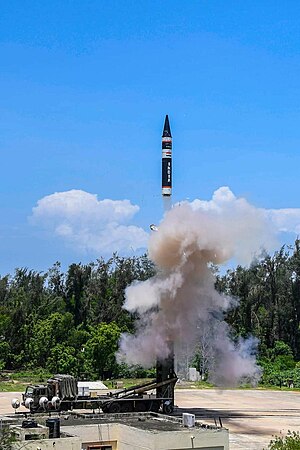Context:
Recently, a successful flight test was conducted of the New Generation Ballistic Missile Agni-Prime.
More on the news
- Strategic Forces Command (SFC), along with the Defence Research and Development Organisation (DRDO), conducted the successful flight test of New Generation nuclear-capable Ballistic Missile Agni-Prime from Dr APJ Abdul Kalam Island off the coast of Odisha.
• India also successfully conducted the first flight test of an indigenously developed Agni-5 missile based on MIRVs or multiple independently targetable re-entry vehicles last month.
The Strategic Forces Command (SFC)
It forms part of India’s Nuclear Command Authority (NCA). It is responsible for the management and administration of the country’s tactical and strategic nuclear weapons stockpile. It was created on January 4, 2003.
- MIRVs can carry multiple warheads which can be released from the missile at different speeds and in different directions.
Agni-Prime Missile
- Agni-P has a range of 1,000-2,000 km, and has significant upgrades, which include composite motor casing, manoeuvrable reentry vehicle (MaRV), improved propellants, and navigation and guidance systems.
- It was tested for the first time in June 2021.
- The ‘Agni-P’ missile is lighter than all the earlier Agni series of missiles.
- Agni-Prime is a canisterised missile, which means that it is stored in a launch tube or canister, unlike other missiles that are exposed to the outside environment.
- Agni-P is a two-stage canister, solid propellant ballistic missile with a dual redundant navigation and guidance system.
- Since the missile is canisterised, it can be transported by road and rail and stored for longer periods, significantly reducing the time required for preparation and launch.
- The origin of the Agni series missile is in the Integrated Guided Missile Development Programme (IGMDP) which was, to develop a family of strategic and tactical guided missiles it was approved by the Government of India on July 26, 1983.
- The missile uses a cold launch mechanism.
| Cold launch mechanism | Hot launch mechanism | |
| Definition | The missile is ejected out of its container, usually by means of compressed gass, before the rocket engine kicks in while the missile is in flight. | The missile propels itself out of the container using its own rocket engine. |
| Advantage | It can eject the missile thereby reducing or eliminating the threat. | The missile propels itself out of the launching cell using its own engine, which eliminates the need for a separate system to eject the missile from the launching tube. |
Significance of the Agni-P
- The successful development and induction of the missile will be an excellent force multiplier for the Armed Forces.
- It enhances its flexibility in various operational scenarios, providing greater tactical advantages to the armed forces.

